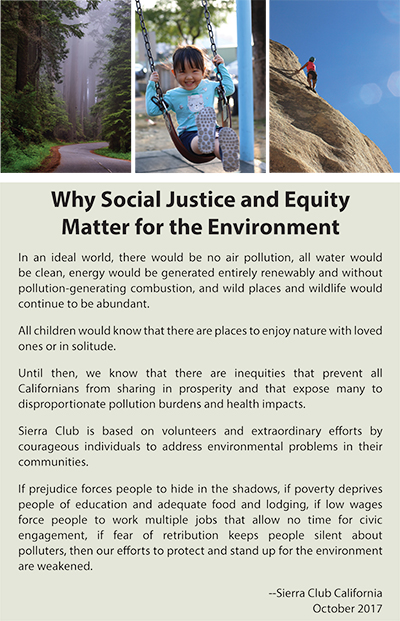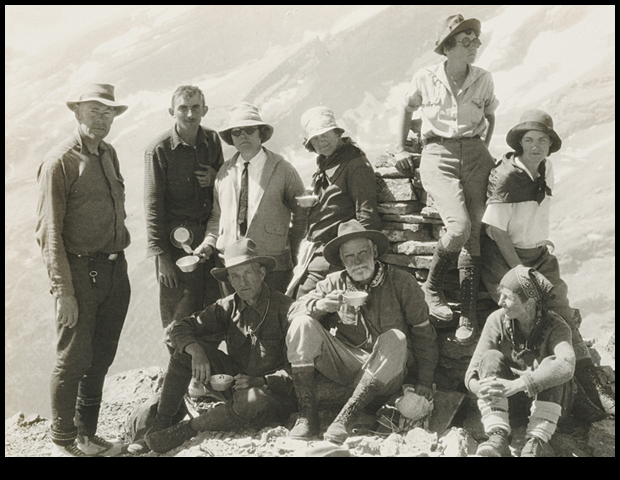
October 28, 2018
I recently stumbled across an online Sierra Club archive for a commemorative book of photographs of a 1928 hiking trip to the Canadian Rockies. The photographs were taken by Ansel Adams, the famed photographer, before he was so well known.
Photo by Ansel Adams
It was just the second time Adams attended one of the Club’s famous high-country trips. In a photograph on page 40 of the book (slide 45), he is a skinny young man, free of the full beard and big, wide-brimmed hat that became his trademark.
But the young Adams isn’t the most interesting thing about that photo. Instead, it’s that of the nine people posing on a mountain peak with Adams, five are women. This is in 1928. This is just eight years after the passage of the 19th amendment granting women the right to vote. This is a time when stereotypes of women as frail creatures blocked so many from opportunities to have powerful jobs, earn a fair living, or enjoy rugged recreation.
The Club managed to be a place that opened up opportunities to women from its early years just by allowing them access. Even from the first years, Club leaders realized that offering access to the outdoors could forge a broader love for and change attitudes about nature and the environment.
Access. So simple.
Some of those Club leaders weren’t perfect. Some were overtly racist. Another thing that is notable in old photos is that the participants were all white.
Fortunately, times change.
One of the signs of change is that in the last couple of decades, first gradually and now fully and at the direction of the national board of directors, Sierra Club staff and volunteer leaders have been immersed in a combination of trainings, discussions and experiences to address and abandon the vestiges of the organization’s racism.
This hasn’t been easy. It has required looking deeply at our own, individual and ugly prejudice. It has required the organization as a whole to examine how it does things, how it takes positions on issues, what issues it should focus on, and how it must treat people.
Sierra Club still is about exploring, enjoying and protecting the planet. But now the emphasis is on everyone having the opportunity, the right, to participate and lead. It’s about access. But it’s also about equity, inclusion and justice.
As Nellis Kennedy-Howard, the Club’s national director of the Department of Equity, Inclusion and Justice, has said, “This is just the beginning of a long journey for Sierra Club; by centering our key principles of equity, inclusion and justice in every aspect of our work, we aim to transform ourselves and build a healthy, welcoming and sustainable community that celebrates people from all walks of life.”
In the world of environmental policy making in California, as we are considering what bills to actively support, the values of equity, inclusion and justice have helped steer us to legislation or positions that are a step away from the traditional tree-hugger issues. We’ve recently taken positions on bills to end money bail, to allow sanctuary to immigrants, to raise the minimum wage, and to expand farmworker rights.
We have also made more effort to confer with and include our allies in environmental justice groups into conversations about our key issues. And we have shaped some of our bill positions to be more responsive to those allies’ needs. We follow principles worked out in 1996 and expressed in a document called the Jemez Principles.
Our volunteer leadership gets the need for equity and inclusion. But sometimes, for people inside and outside the Club who haven’t been immersed in the years of internal discussions about the Club’s purpose and what we can and need to become, our positions can be confusing.
Why, for instance, did we reject a bill about housing that might reduce climate emissions, but would also likely displace low-income renters? Since when are low-income renters our concern? Or why did we support a bill that would protect immigrants from intimidation?

About a year ago, as Sierra Club California’s executive committee and I were trying to express what we want to see in a governor, we found a short way to explain why. Caring about everyone, ensuring that everyone has the freedom to live without fear and become a fully engaged member of civic debate about environmental policy, is more than just the right thing to do. It’s the thing to do if we want to make sure there is still a community brave enough and able enough to protect the environment.
We’ve made a poster that explains this with a few more words. You can download it here.
When I first became involved in Sierra Club more than four decades ago, I did it because I wanted a safe place to hike, backpack and enjoy nature. The Club I know today still does that, but so much more. It’s changed for the better.
Access plus.
Sincerely,

Kathryn Phillips
Director
Sierra Club California is the Sacramento-based legislative and regulatory advocacy arm of the 13 California chapters of the Sierra Club.
Please consider making a monthly donation.
